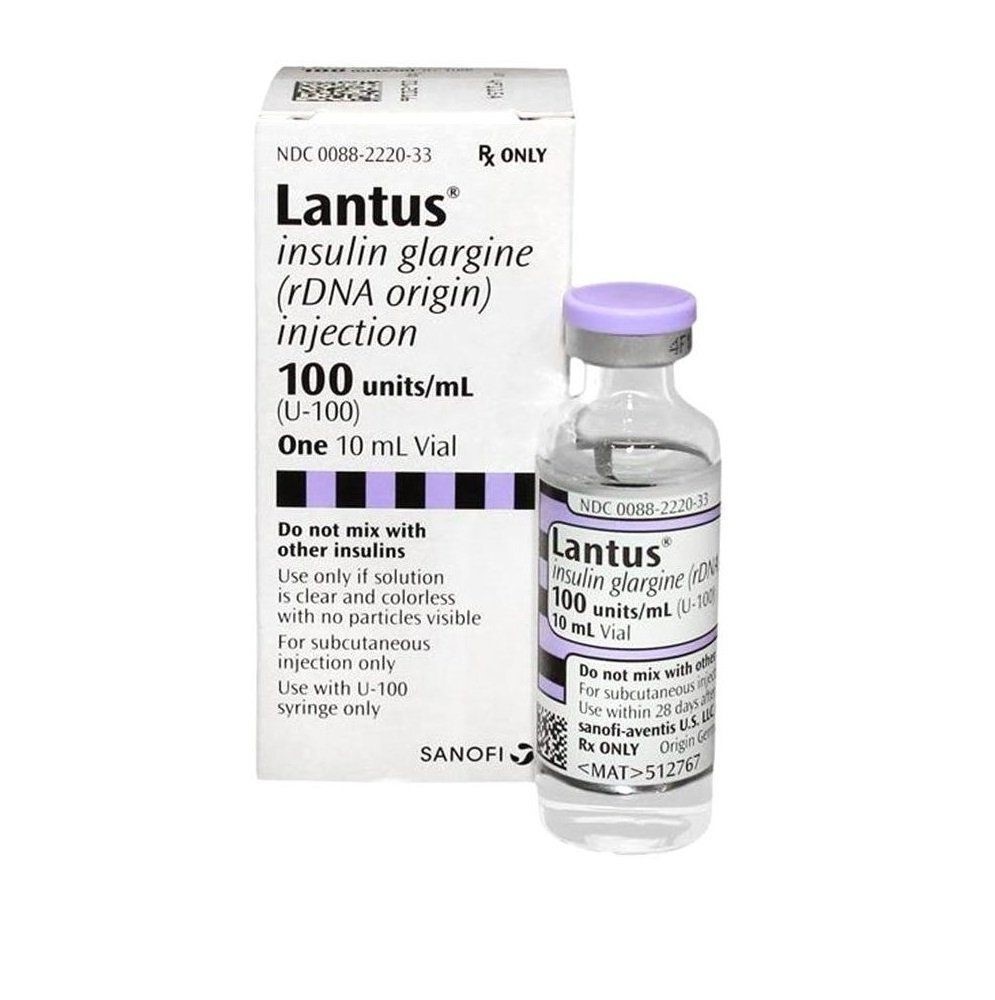

ЛАНТУС 100 ОД/мл розчин для ін'єкцій у флаконі

Запитайте лікаря про рецепт на ЛАНТУС 100 ОД/мл розчин для ін'єкцій у флаконі

Інструкція із застосування ЛАНТУС 100 ОД/мл розчин для ін'єкцій у флаконі
Вступ
Опис: інформація для користувача
Лантус 100одиниці/мл ін'єкційне розчин у флаконі
Інсулін гларгін
Всією увагою прочитайте цей опис перед початком використання цього лікарського засобу, оскільки він містить важливу інформацію для вас.
- Збережіть цей опис, оскільки вам може знадобитися знову його прочитати.
- Якщо у вас є якісь питання, проконсультуйтеся з вашим лікарем, фармацевтом або медсестрою.
- Цей лікарський засіб призначений тільки вам, і не слід давати його іншим людям, навіть якщо вони мають相同ні симптоми, оскільки це може їм нашкодити.
- Якщо ви відчуваєте побічні ефекти, проконсультуйтеся з вашим лікарем або фармацевтом, навіть якщо це побічні ефекти, які не вказані в цьому описі. Див. розділ 4.
Зміст опису
- Що таке Лантус і для чого він використовується
- Що потрібно знати перед початком використання Лантуса
- Як використовувати Лантус
- Можливі побічні ефекти
- Збереження Лантуса
- Зміст упаковки та додаткова інформація
1. Що таке Лантус і для чого він використовується
Лантус містить інсулін гларгін. Це модифікований інсулін, дуже подібний до людського інсуліну.
Лантус використовується для лікування цукрового діабету у дорослих, підлітків і дітей від 2 років. Цукровий діабет - це захворювання, при якому організм не виробляє достатньої кількості інсуліну для контролю рівня цукру в крові. Інсулін гларгін має тривалу і стабільну дію щодо зниження рівня цукру в крові.
2. Що потрібно знати перед початком використання Лантуса
Не використовуйтеЛантус
Якщо ви алергічні на інсулін гларгін або на будь-який інший компонент цього лікарського засобу (включаючи розділ 6).
Попередження та обережність
Проконсультуйтеся з вашим лікарем, фармацевтом або медсестрою перед початком використання Лантуса.
Суворо дотримуйтесь інструкцій щодо дозування, контролю (аналізів крові та сечі), дієти та фізичної активності (фізичної праці та вправ), які встановив ваш лікар.
Якщо ваш рівень цукру в крові занадто низький (гіпоглікемія), дотримуйтесь інструкцій щодо гіпоглікемії (див. розділ, який знаходиться в кінці цього опису).
Зміни шкіри в місці ін'єкції
Необхідно змінювати місце ін'єкції, щоб уникнути змін шкіри, таких як бугорки під шкірою. Інсулін може не діяти дуже добре, якщо його вводять в зону з бугорками (див. Як використовувати Лантус). Проконсультуйтеся з вашим лікарем, якщо ви зараз вводите інсулін в зону з бугорками, перед тим як почнете вводити його в іншу зону. Ваш лікар може порадити вам перевірити рівень цукру в крові більш часто та调整 інсулін або дозу інших антидіабетичних лікарських засобів.
Подорожі
Перед подорожжю проконсультуйтеся з вашим лікарем. Можливо, вам потрібно буде обговорити:
- доступність інсуліну в країні, яку ви плануєте відвідати,
- резерв інсуліну, шприців тощо,
- правильне зберігання інсуліну під час подорожі,
- графік прийому їжі та інсуліну під час подорожі,
- можливі ефекти зміни часових поясів,
- можливі нові ризики для здоров'я в країнах, які ви плануєте відвідати,
- що потрібно робити в ситуаціях нагальної потреби, коли ви відчуваєте себе погано або захворіли.
Хвороби та травми
Управління вашим діабетом може потребувати особливого уходу в таких ситуаціях (наприклад, корекції дози інсуліну, аналізів крові та сечі):
- Якщо ви хворі або маєте важку травму, ваш рівень цукру в крові може підвищитися (гіперглікемія).
- Якщо ви не їсте достатньо, ваш рівень цукру в крові може знижитися занадто низько (гіпоглікемія).
У більшості випадків вам потрібно буде проконсультуватися з лікарем. Переконайтеся, що ви негайно проконсультуєтеся з лікарем.
Якщо ви маєте цукровий діабет 1-го типу (діабет, залежний від інсуліну), не припиняйте приймати інсулін та дотримуйтесь достатнього споживання вуглеводів. Звічай повідомляйте людей, які займаються вашим лікуванням, що вам потрібно інсулін.
Лікування інсуліном може спричинити вироблення антитіл до інсуліну (речовин, які діють проти інсуліну). Однак лише в дуже рідкісних випадках вам потрібно буде змінити дозу інсуліну.
Деякі пацієнти з цукровим діабетом 2-го типу з тривалим перебігом та попереднім захворюванням серця або інсультом, які були behandені піоглітазоном (оральним антидіабетическим лікарським засобом, використовуваним для лікування цукрового діабету 2-го типу) та інсуліном, мали розвиток серцевої недостатності. Повідомте вашому лікареві якнайшвидше, якщо ви відчуваєте ознаки серцевої недостатності, такі як незвичайна короткість дыхання або швидке збільшення ваги чи локалізована набряклість (едем).
Діти
Немає досвіду використання Лантуса у дітей молодших 2 років.
Використання Лантуса з іншими лікарськими засобами
Деякі лікарські засоби можуть змінювати рівень цукру в крові (збільшувати, зменшувати або обидва, залежно від ситуації). У кожному випадку може знадобитися корекція дози інсуліну, щоб уникнути занадто низьких або занадто високих рівнів цукру в крові. Будьте обережні, коли починаєте приймати інший лікарський засіб, а також коли припиняєте його приймати.
Повідомте вашому лікареві або фармацевту, якщо ви приймаєте, нещодавно приймали або можете приймати будь-який інший лікарський засіб. Спитайте вашого лікаря, перш ніж приймати лікарський засіб, чи може він впливати на рівень цукру в крові, та які заходи вам потрібно вжити в цьому випадку.
Серед лікарських засобів, які можуть спричинити зниження рівня цукру в крові (гіпоглікемію), включають:
- всі інші лікарські засоби для лікування цукрового діабету,
- інгібітори ангіотензинперетворюючого ферменту (АПФ) (використовувані для лікування певних захворювань серця або підвищеного артеріального тиску),
- дісопірамід (використовуваний для лікування певних захворювань серця),
- флуоксетин (використовуваний для лікування депресії),
- фібрати (використовувані для зниження рівня ліпідів в крові),
- інгібітори моноамінооксидази (МАО) (використовувані для лікування депресії),
- пентоксифілін, пропоксифен, саліцилати (такі як ацетилсаліцилова кислота, використовувана для полегшення болю та зниження температури),
- антібіотики групи сульфаніламідів.
Серед лікарських засобів, які можуть спричинити підвищення рівня цукру в крові (гіперглікемію), включають:
- кортикостероїди (такі як "кортизон", використовуваний для лікування запалення),
- даназол (лікарський засіб, який впливає на овуляцію),
- діазоксид (використовуваний для лікування підвищеного артеріального тиску),
- діуретики (використовувані для лікування підвищеного артеріального тиску або надмірної ретенції рідини),
- глюкагон (підшлункова гормона, використовувана для лікування гіпоглікемії),
- ізоніазид (використовуваний для лікування туберкульозу),
- естрогени та прогестагени (такі як у контрацептивних таблетках, використовуваних для контролю над народжуваністю),
- похідні фенотіазину (використовувані для лікування психіатричних захворювань),
- соматотропін (гормон росту),
- симпатоміметичні лікарські засоби (такі як адреналін, салбутамол, тербуталін для лікування астми),
- гормони щитоподібної залози (використовувані для лікування порушення функції щитоподібної залози),
- атипічні антипсихотичні лікарські засоби (такі як клозапін, оланзапін),
- інгібітори протеази (використовувані для лікування ВІЛ).
Ваш рівень цукру в крові може підвищитися або знижитися, якщо ви приймаєте:
- бета-блокатори (використовувані для лікування підвищеного артеріального тиску),
- клонідин (використовувана для лікування підвищеного артеріального тиску),
- солі літію (використовувані для лікування психіатричних захворювань).
Пентамідин (використовуваний для лікування деяких інфекцій, спричинених паразитами) може спричинити гіпоглікемію, яка іноді може бути слідована гіперглікемією.
Бета-блокатори, а також інші симпатоміметичні лікарські засоби (такі як клонідин, гуанетидин та резерпін) можуть зменшувати або повністю припиняти перші ознаки гіпоглікемії, які можуть допомогти вам розпізнати її.
Якщо ви не впевнені, чи приймаєте ви якийсь із цих лікарських засобів, проконсультуйтеся з вашим лікарем або фармацевтом.
Використання Лантуса з алкоголем
Ваш рівень цукру в крові може підвищитися або знижитися, якщо ви споживаєте алкоголь.
Вагітність та лактація
Проконсультуйтеся з вашим лікарем або фармацевтом перед прийняттям будь-якого лікарського засобу.
Повідомте вашому лікареві, якщо ви плануєте вагітність або вже вагітні. Ваша доза інсуліну може потребувати корекції під час вагітності та після пологів. Особливо ретельний контроль над діабетом та профілактика гіпоглікемії важливі для здоров'я вашої дитини.
Якщо ви перебуваєте в періоді лактації, проконсультуйтеся з вашим лікарем, оскільки вам може знадобитися корекція дози інсуліну та дієти.
Водіння автомобіля та використання машин
Ваша здатність концентрації або реакції може бути знижена, якщо:
- у вас гіпоглікемія (низький рівень цукру в крові),
- у вас гіперглікемія (високий рівень цукру в крові),
- у вас проблеми з зором.
Будьте обережні щодо цього можливого ризику, враховуючи всі ситуації, які можуть бути причиною ризику для вас або інших (наприклад, водіння автомобіля чи використання машин). Ви повинні попросити вашого лікаря про пораду щодо здатності водіння, якщо:
- у вас часто повторюються епізоди гіпоглікемії,
- зменшилися або не з'являються перші ознаки гіпоглікемії, які можуть допомогти вам розпізнати її.
Важлива інформація про деякі компоненти Лантуса
Цей лікарський засіб містить менше 1 ммоль (23 мг) натрію на дозу, тобто він практично не містить натрію.
3. Як використовувати Лантус
Слідуйте точно інструкціям щодо застосування цього лікарського засобу, вказаним вашим лікарем. У разі сумнівів проконсультуйтеся з вашим лікарем або фармацевтом.
Хоча Лантус містить той самий активний інгредієнт, що і Туджео (інсулін гларгін 300 одиниць/мл), ці лікарські засоби не є взаємозамінними. Зміна лікування інсуліном потребує призначення лікаря, медичного нагляду та контролю рівня цукру в крові. Для більшої інформації проконсультуйтеся з вашим лікарем.
Доза
У залежності від вашого способу життя та результатів контролю рівня цукру в крові та попереднього лікування інсуліном, ваш лікар:
- визначить дозу Лантуса, яку вам потрібно приймати кожен день та о якій годині,
- порадить вам, коли потрібно аналізувати рівень цукру в крові та чи потрібно проводити аналіз сечі,
- порадить вам, коли вам потрібно вводити вищу або нижчу дозу Лантуса.
Лантус - це інсулін тривалої дії. Ваш лікар може порадити вам використовувати його в поєднанні з інсуліном короткої дії або з таблетками для лікування підвищення рівня цукру в крові.
Багато факторів можуть впливати на рівень цукру в крові. Ви повинні знати ці фактори, щоб правильно реагувати на зміни рівня цукру в крові та уникнути його підвищення або зниження. Для більшої інформації див. розділ, який знаходиться в кінці опису.
Використання в дітей та підлітків
Лантус можна використовувати в підлітків та дітей від 2 років. Використовуйте цей лікарський засіб так, як вказав ваш лікар.
Частота застосування
Вам потрібно вводити ін'єкцію Лантуса кожен день, завжди о тій самій годині.
Форма застосування
Лантус вводиться під шкіру. НЕ вводьте Лантус в вену, оскільки це змінить його дію та може спричинити гіпоглікемію.
Ваш лікар покаже вам, в якій області шкіри вам потрібно вводити Лантус. З кожною ін'єкцією потрібно змінювати місце уколу всередині конкретної області шкіри, яку ви використовуєте.
Як обробляти флакони
Перед використанням флакона перевірте його. Його можна використовувати тільки якщо розчин прозорий, безколірний та водянистий, та не містить видимих частинок. Неagitуйте та не змішуйте перед використанням. Переконайтеся, що інсулін не забруднюється алкоголем чи іншими дезінфікуючими засобами, а також іншими речовинами. Не змішуйте Лантус з будь-яким іншим інсуліном чи лікарським засобом. Не розбавляйте його. Ваше змішування чи розбавлення можуть змінити дію Лантуса.
Використовуйте завжди новий флакон, якщо ви спостерігаєте, що контроль над рівнем цукру в крові погіршується несподівано. Це відбувається через те, що інсулін може втрачати свою ефективність. Якщо ви вважаєте, що у вас є проблема з Лантусом, попросіть вашого лікаря або фармацевта перевірити його.
Помилки з інсуліном
Ви повинні завжди перевірити етикетку інсуліну перед кожною ін'єкцією, щоб уникнути помилок між Лантусом та іншими інсулінами.
Якщо ви приймаєте більше Лантуса, ніж потрібно
- Якщо ви ввели надто багато Лантуса, ваш рівень цукру в крові може стати занадто низьким (гіпоглікемія).
Перевіряйте рівень цукру в крові часто. Загалом, для профілактики гіпоглікемії вам потрібно більше їсти та контролювати рівень цукру в крові. Для більшої інформації про лікування гіпоглікемії див. розділ, який знаходиться в кінці опису.
Якщо ви забули прийняти Лантус
- Якщо ви забули прийняти дозу Лантуса або якщо ви не ввели достатньо інсуліну, ваш рівень цукру в крові може підвищитися занадто високо (гіперглікемія). Перевіряйте рівень цукру в крові часто.
Для більшої інформації про лікування гіперглікемії див. розділ, який знаходиться в кінці опису.
- Не приймайте подвійну дозу, щоб компенсувати забуті дози.
Якщо ви припиняєте лікування Лантусом
Це може спричинити гіперглікемію та кетоацидоз (підвищення рівня кислотності в крові, оскільки організм розкладає жири замість цукру). Не припиняйте лікування Лантусом без консультації з вашим лікарем, він порадить вам, що потрібно робити.
Якщо у вас є якісь інші питання щодо використання цього лікарського засобу, проконсультуйтеся з вашим лікарем, фармацевтом або медсестрою.
4. Можливі побічні ефекти
Як і всі лікарські засоби, Лантус може спричиняти побічні ефекти, хоча не всі люди їх відчувають.
Якщо ви спостерігаєте ознаки того, що ваш рівень цукру в крові занадто низький (гіпоглікемія),негайно діяйте, щоб підвищити рівень цукру в крові (див. розділ, який знаходиться в кінці цього опису). Гіпоглікемія (низький рівень цукру в крові) може бути дуже серйозною та є досить поширеною під час лікування інсуліном (може впливати понад 1 з 10 людей). Низький рівень цукру в крові означає, що в крові недостатньо цукру. Якщо ваш рівень цукру в крові знижується занадто низько, ви можете втратити свідомість (зупинити дихання). Серйозна гіпоглікемія може спричинити пошкодження мозку та бути потенційно смертельною. Для більшої інформації див. розділ, який знаходиться в кінці цього опису.
Серйозні алергічні реакції(рідко, можуть впливати до 1 з 1000 людей) - ознаки можуть включати великомасштабні шкірні реакції (ерупція та свербіж по всьому тілу), сильне набряклення шкіри або слизових оболонок (ангіоедем), труднощі з диханням, зниження артеріального тиску з швидким серцебиттям та потінням. Серйозні алергічні реакції на інсулін можуть бути потенційно смертельними.Негайно повідомте вашому лікареві, якщо ви спостерігаєте ознаки серйозних алергічних реакцій.
- Зміни шкіри в місці ін'єкції:
Якщо ви вводите інсулін занадто часто в одному місці, тканина під шкірою може зменшилася (ліпоатрофія) (може впливати до 1 з 100 людей) або стати товще (ліпогіпертрофія) (може впливати до 1 з 10 людей). Бугорки під шкірою також можуть виникнути через накопичення білка, званого амілоїдом (кутанна амілоїдоз; не відомо, з якою частотою це відбувається). Інсулін може не діяти дуже добре, якщо його вводять в зону з бугорками (див. Як використовувати Лантус). Змініть місце ін'єкції, щоб допомогти уникнути цих змін шкіри.
Часті побічні ефекти(можуть впливати до 1 з 10 людей)
- Побічні ефекти шкіри та алергічні реакції в місці ін'єкції
Ознаки можуть включати червоність, сильний біль при ін'єкції, свербіж, кропив'янка, набряклення або запалення. Ці реакції можуть поширюватися навколо місця ін'єкції. Більшість легких реакцій на інсулін зникають зазвичай за кілька днів або тижнів.
Рідкі побічні ефекти(можуть впливати до 1 з 1000 людей)
- Очні реакції
Значна зміна (поліпшення або погіршення) контролю рівня цукру в крові може тимчасово змінити ваш зір. Якщо ви маєте проліферативну ретинопатію (захворювання очей, пов'язане з діабетом), серйозні гіпоглікемічні атаки можуть спричинити тимчасову втрату зору.
- Загальні розлади
У рідкісних випадках лікування інсуліном також може спричинити тимчасову ретенцію рідини в організмі, з набрякленням гомілок та стоп.
Дуже рідкі побічні ефекти(можуть впливати до 1 з 10 000 людей)
У дуже рідкісних випадках може виникнути дисгевзія (розлади смаку) та міалгія (м'язовий біль).
Використання в дітей та підлітків
Загалом, побічні ефекти в дітей та підлітків до 18 років подібні до тих, які спостерігаються у дорослих.
Було повідомлено про більш часте виникнення реакцій в місці ін'єкції (біль в місці ін'єкції, реакція в місці ін'єкції) та шкірних реакцій (ерупція, кропив'янка) у дітей та підлітків до 18 років, ніж у дорослих.
Не існує досвіду використання Лантуса у дітей молодших 2 років.
Повідомлення про побічні ефекти
Якщо ви відчуваєте будь-який побічний ефект, проконсультуйтеся з вашим лікарем або фармацевтом, навіть якщо це можливі побічні ефекти, які не вказані в цьому описі. Ви також можете повідомити про них безпосередньо через національну систему повідомлення, вказану в додатку V. Повідомляючи про побічні ефекти, ви можете допомогти забезпечити більше інформації про безпеку цього лікарського засобу.
5. Зберігання Лантуса
Тримати цей лікарський засіб поза зоною видимості та доступу дітей.
Не використовувати цей лікарський засіб після закінчення терміну придатності, вказаного на упаковці та на етикетці флакона після CAD/EXP. Термін придатності - останній день місяця, зазначеного на упаковці.
Невідкриті флакони
Зберігати у холодильнику (між 2°C та 8°C). Не заморожувати та не ставити поряд з морозильною камерою чи охолоджувачем. Тримати флакон у зовнішній упаковці, щоб захистити його від світла.
Відкриті флакони
Після відкриття флакон об'ємом 5 мл можна зберігати протягом максимум 4 тижнів у зовнішній упаковці при температурі нижче 25°C та захисту від тепла чи прямого світла.
Після відкриття флакон об'ємом 10 мл можна зберігати протягом максимум 4 тижнів у зовнішній упаковці при температурі нижче 30°C та захисту від тепла чи прямого світла.
Не використовувати флакон після закінчення цього терміну. Рекомендується записати на етикетці дату першого використання.
Не використовувати Лантус, якщо ви помітили будь-які частинки всередині. Лантус повинен бути прозорим, безбарвним та водянистим.
Лікарські засоби не повинні викидатися у водопровід чи сміття. Спитайте у свого фармацевта, як позбутися упаковок та лікарських засобів, які вам більше не потрібні. Таким чином, ви допоможете захистити навколишнє середовище.
6. Зміст упаковки та додаткова інформація
Склад Лантуса
- Активний інгредієнт - інсулін гларгін. Кожен мілілітр розчину містить 100 одиниць інсуліну гларгіна (еквівалентно 3,64 мг).
- Інші компоненти: хлорид цинку, метакрезол, гліцерол, гідроксид натрію (див. розділ 2 "Важлива інформація про деякі компоненти Лантуса") та хлоридна кислота (для регулювання pH), полісорбат 20 (тільки у флаконах об'ємом 10 мл) та вода для ін'єкцій.
Вигляд продукту та вміст упаковки
Лантус 100 одиниць/мл ін'єкційний розчин у флаконі - прозорий, безбарвний та водянистий розчин.
Кожен флакон містить 5 мл ін'єкційного розчину (еквівалентно 500 одиниць) або 10 мл ін'єкційного розчину (еквівалентно 1000 одиниць).
Упаковки по 1, 2, 5 та 10 флаконів об'ємом 5 мл або 1 флакон об'ємом 10 мл.
Можливо, що тільки деякі розміри упаковок будуть доступні.
Власник дозволу на маркетинг та відповідальна особа за виробництво
Sanofi-Aventis Deutschland GmbH, D-65926 Франкфурт-на-Майні, Німеччина.
Для отримання додаткової інформації щодо цього лікарського засобу зверніться до місцевого представника власника дозволу на маркетинг.
Бельгія/Бельгія/Німеччина Sanofi Belgium Телефон/Телефон: +32 (0)2 710 54 00 | Литва Swixx Biopharma UAB Телефон: +370 5 236 91 40 |
Болгарія Swixx Biopharma EOOD Телефон: +359 (0)2 942 480 | Люксембург/Люксембург Sanofi Belgium Телефон/Телефон: +32 (0)2 710 54 00 (Бельгія/Німеччина) |
Чехія Sanofi s.r.o. Телефон: +420 233 086 111 | Угорщина SANOFI-AVENTIS Zrt. Телефон: +36 1 505 0050 |
Данія Sanofi A/S Телефон: +45 45 16 70 00 | Мальта Sanofi S.r.l. Телефон: +39 02 39394275 |
Німеччина Sanofi-Aventis Deutschland GmbH Телефон: 0800 52 52 010 Телефон з-за кордону: +49 69 305 21 131 | Нідерланди Sanofi B.V. Телефон: +31 20 245 4000 |
Естонія Swixx Biopharma OÜ Телефон: +372 627 34 88 | Норвегія sanofi-aventis Norge AS Телефон: +47 67 10 71 00 |
Греція Sanofi-Aventis Μονοπρ?σωπη AEBE Телефон: +30 210 900 16 00 | Австрія sanofi-aventis GmbH Телефон: +43 1 80 185 – 0 |
Іспанія sanofi-aventis, S.A. Телефон: +34 93 485 94 00 | Польща Sanofi Sp. z o.o. Телефон: +48 22 280 00 00 |
Франція Sanofi Winthrop Industrie Телефон: 0 800 222 555 Дзвінок з-за кордону: +33 1 57 63 23 23 | Португалія Sanofi - Produtos Farmacêuticos, Lda Телефон: +351 21 35 89 400 |
Хорватія Swixx Biopharma d.o.o. Телефон: +385 1 2078 500 | Румунія Sanofi Romania Телефон: +40 (0) 21 317 31 36 |
Ірландія sanofi-aventis Ireland Ltd. T/A SANOFI Телефон: +353 (0) 1 403 56 00 | Словенія Swixx Biopharma d.o.o. Телефон: +386 1 235 51 00 |
Ісландія Vistor hf. Телефон: +354 535 7000 | Словаччина Swixx Biopharma s.r.o. Телефон: +421 2 208 33 600 |
Італія Sanofi S.r.l. Телефон: 800 13 12 12 (технічні питання) 800.536389 (інші питання) | Фінляндія Sanofi Oy Телефон: +358 (0) 201 200 300 |
Кіпр C.A. Papaellinas Ltd. Телефон: +357 22 741741 | Швеція Sanofi AB Телефон: +46 (0)8 634 50 00 |
Латвія Swixx Biopharma SIA Телефон: +371 6 616 47 50 | Велика Британія(Північна Ірландія) sanofi-aventis Ireland Ltd. T/A SANOFI Телефон: +44 (0) 800 035 2525 |
Дата останнього перегляду цього посібника:
Інші джерела інформації
Детальна інформація про цей лікарський засіб доступна на сайті Європейського агентства з лікарських засобів: http://www.ema.europa.eu/
ГІПЕРГЛЮКЕМІЯ ТА ГІПОГЛЮКЕМІЯ
Завжди носіть з собою щось солодке (мінімум 20 грамів).
Завжди носіть з собою інформацію, яка свідчить про те, що ви діабетик.
ГІПЕРГЛЮКЕМІЯ (високий рівень цукру в крові)
Якщо у вас дуже високий рівень цукру в крові (гіперглюкемія), ви, можливо, не ввели достатньо інсуліну.
Чому у вас виникла гіперглюкемія?
Деякі приклади:
- ви не ввели інсулін або ввели недостатню кількість, або якщо його дія зменшилася, наприклад, через неправильне зберігання,
- ви робите менше фізичних вправ, ніж зазвичай, або переживаєте стрес (емоційний, нервовий), або страждаєте від травми, операції, інфекції чи гарячки,
- ви приймаєте або приймали певні лікарські засоби (див. розділ 2, "Вживання Лантуса з іншими лікарськими засобами").
Симптоми попередження гіперглюкемії
Спрага, збільшення потреби в сечовипусканні, втома, сухість шкіри, червоний колір обличчя, втрата апетиту, низький тиск, швидке серцебиття та наявність глюкози та кетонових тіл у сечі. Біль у животі, глибоке та швидке дихання, сонливість або навіть втрата свідомості можуть бути ознаками серйозного стану (кетоацидозу) через відсутність інсуліну.
Що ви повинні зробити, якщо у вас виникла гіперглюкемія?
Ви повинні проаналізувати рівень цукру в крові та рівень ацетону в сечі якнайшвидше після появи будь-яких із цих симптомів.Гіперглюкемія або серйозний кетоацидоз повинні бути завжди лікувані лікарем, зазвичай у лікарні.
ГІПОГЛЮКЕМІЯ (низький рівень цукру в крові)
Якщо рівень цукру в крові знижується надто швидко, ви можете втратити свідомість. Серйозна гіпоглюкемія може спричинити інфаркт чи пошкодження мозку та загрожувати вашому життю. Зазвичай ви повинні бути здатні визначити, коли рівень цукру в крові знижується надто швидко, щоб вжити необхідні заходи.
Чому у вас виникла гіпоглюкемія?
Деякі приклади:
- ви ввели надто багато інсуліну,
- ви пропустили прийом їжі або відтермінували його,
- ви не їсте достатньо, або їсте продукти, які містять менше вуглеводів, ніж зазвичай (цукор та речовини, подібні до цукру, називаються вуглеводами; однак, штучні солодкі речовини не є вуглеводами),
- ви втрачаєте вуглеводи через блювоту чи діарею,
- ви п'єте алкоголь, особливо якщо ви не їсте багато,
- ви робите більше фізичних вправ, ніж зазвичай, або інший тип фізичної активності,
- ви відновлюєтеся після травми, операції чи іншого типу стресу,
- ви відновлюєтеся після хвороби чи гарячки,
- ви приймаєте або припиняєте прийом певних лікарських засобів (див. розділ 2, "Вживання Лантуса з іншими лікарськими засобами").
Також гіпоглюкемія більш ймовірна, якщо:
- ви щойно почали лікування інсуліном або змінили інсулін (коли ви змінюєте свій попередній базовий інсулін на Лантус, гіпоглюкемія більш ймовірна вранці, ніж увечері),
- ваш рівень цукру в крові майже нормальний або нестабільний,
- ви змінили місце введення інсуліну (наприклад, з стегна на верхню частину руки),
- ви страждаєте від серйозної хвороби нирок чи печінки, або іншої хвороби, наприклад, гіпотиреозу.
Симптоми попередження гіпоглюкемії
- У вашому тілі
Приклади, які свідчать про те, що рівень цукру в крові знижується надто швидко: пот, волога та липка шкіра, тривога, швидке серцебиття, високий тиск, серцебиття та нерегулярне серцебиття. Ці симптоми часто виникають до появи симптомів низького рівня цукру в мозку.
- У вашому мозку
Приклади, які свідчать про те, що рівень цукру в мозку низький: головний біль, сильний голод, нудота, блювота, втома, сонливість, порушення сну, тривога, агресивна поведінка, порушення концентрації, зміни реакції, депресія, сплутаність, порушення мови (іноді, повна втрата мови), порушення зору, тремор, параліч, відчуття оніміння та поколювання (парестезії), відчуття оніміння та поколювання в області рота, головокружіння, втрата контролю, відчуття безпорадності, судоми, втрата свідомості.
Перші симптоми попередження гіпоглюкемії ("симптоми попередження") можуть змінюватися, зменшуватися або зовсім зникати, якщо:
- ви людина похилого віку,
- ви страждаєте від діабету протягом тривалого часу,
- ви страждаєте від певного типу нервової хвороби (діабетична автономна нейропатія),
- ви недавно пережили епізод гіпоглюкемії (наприклад, вчора) або якщо вона розвивається поступово,
- ви маєте майже нормальний або покращений рівень цукру в крові,
- ви недавно змінили інсулін тваринного походження на інсулін людського походження, наприклад Лантус.
- ви приймаєте або припиняєте прийом певних лікарських засобів (див. розділ 2, "Вживання Лантуса з іншими лікарськими засобами").
У цьому випадку ви можете пережити серйозну гіпоглюкемію (і навіть втратити свідомість) до того, як зрозумієте проблему. Завжди бути знайомим зі своїми симптомами попередження. Якщо це необхідно, частіше проводити аналіз рівня цукру в крові може допомогти виявити легкі епізоди гіпоглюкемії, які інакше могли б залишитися непоміченими. Якщо ви не впевнені, що можете розпізнати свої симптоми попередження, уникайте ситуацій (наприклад, водіння автомобіля), які можуть поставити вас або інших людей у небезпеку через гіпоглюкемію.
Що ви повинні зробити, якщо у вас виникла гіпоглюкемія?
- Не вводьте інсулін. Вжіть негайно 10-20 грамів цукру, наприклад, глюкозу, цукрові кубики або солодку напій. Увага: штучні солодкі речовини та продукти з цими речовинами замість цукру (наприклад, дієтичні напої) не допомагають при лікуванні гіпоглюкемії.
- Після цього їжте щось, що підвищить рівень цукру в крові на тривалий час (наприклад, хліб або макарони). Ваш лікар або медсестра повинні обговорити це питання з вами раніше.
Відновлення після гіпоглюкемії може бути відкладеним, оскільки Лантус має тривалу дію.
- Якщо гіпоглюкемія повторюється, вжіть ще 10-20 грамів цукру.
- Негайно зверніться до лікаря, якщо ви не можете контролювати гіпоглюкемію або якщо вона повторюється.
Повідомте своїх рідних, друзів та близьких людей:
Якщо ви не можете ковтати або втрачаєте свідомість, вам потрібно буде ввести глюкозу або глюкагон (лікарський засіб, який підвищує рівень цукру в крові). Ці ін'єкції виправдані навіть якщо ви не впевнені, що у вас гіпоглюкемія.
Рекомендується проаналізувати рівень цукру в крові негайно після вживання глюкози, щоб підтвердити, що у вас гіпоглюкемія.

Скільки коштує ЛАНТУС 100 ОД/мл розчин для ін'єкцій у флаконі в Іспанії у 2025 році?
ЛАНТУС 100 ОД/мл розчин для ін'єкцій у флаконі коштує в середньому 37.5 євро у грудень, 2025 році. Ціна може змінюватися залежно від регіону, аптеки та наявності рецепта. Рекомендуємо перевіряти актуальну вартість у місцевих аптеках або через онлайн-сервіси.
- Країна реєстрації
- Середня ціна в аптеках37.5 EUR
- Діючі речовини
- Потрібен рецептТак
- Виробник
- Інформація є довідковою і не є медичною порадою. Перед прийомом будь-яких препаратів обов'язково проконсультуйтеся з лікарем. Oladoctor не несе відповідальності за медичні рішення, прийняті на основі цього контенту.
- Альтернативи до ЛАНТУС 100 ОД/мл розчин для ін'єкцій у флаконіФорма випуску: РОЗЧИН ДЛЯ ІН'ЄКЦІЙ, 100 ОД/млДіючі речовини: insulin glargineВиробник: Eli Lilly Nederland B.V.Потрібен рецептФорма випуску: РОЗЧИН ДЛЯ ІН'ЄКЦІЙ, НевідомоДіючі речовини: insulin glargineВиробник: Sanofi-Aventis Deutschland GmbhПотрібен рецептФорма випуску: ІН'ЄКЦІЙНИЙ, НевідомоДіючі речовини: insulin glargineВиробник: Sanofi-Aventis Deutschland GmbhПотрібен рецепт
Аналоги ЛАНТУС 100 ОД/мл розчин для ін'єкцій у флаконі в інших країнах
Найкращі аналоги з тією самою діючою речовиною та терапевтичним ефектом.
Аналог ЛАНТУС 100 ОД/мл розчин для ін'єкцій у флаконі у Україна
Лікарі онлайн щодо ЛАНТУС 100 ОД/мл розчин для ін'єкцій у флаконі
Консультація щодо дозування, побічних ефектів, взаємодій, протипоказань та поновлення рецепта на ЛАНТУС 100 ОД/мл розчин для ін'єкцій у флаконі – за рішенням лікаря та згідно з місцевими правилами.














